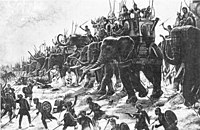Camel cavalry
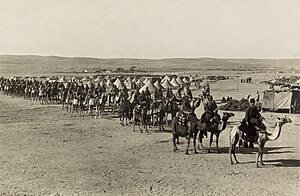
Camel cavalry, or camelry (French: méharistes, pronounced [meaʁist]), is a generic designation for armed forces using camels as a means of transportation. Sometimes warriors or soldiers of this type also fought from camel-back with spears, bows, or firearms.
Camel cavalry was a common element in desert warfare throughout history in the Middle East, due in part to the animals' high level of adaptability. They were better suited to working and surviving in arid environments than the horses of conventional cavalry. The smell of the camel, according to Herodotus, alarmed and disoriented horses, making camels an effective anti-cavalry weapon of the Achaemenid Persians in the Battle of Thymbra.[1][2]
Early history
[edit]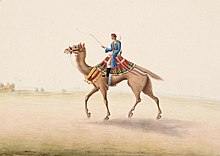
The first recorded use of the camel as a military animal was by the Qedarite Arab king Gindibu, said to have employed as many as 1,000 camels at the Battle of Qarqar in 853 BC. They were reportedly later used in the Battle of Thymbra in 547 BC, between Cyrus the Great of the Achaemenid Empire and Croesus of Lydia. According to Xenophon, Cyrus' cavalry was outnumbered by six to one. Acting on information from one of his generals that the Lydian horses shied away from camels, Cyrus formed the camels from his baggage train into an ad hoc camel corps with armed riders replacing packs. Although not technically employed as cavalry, the camels' smell and appearance were crucial in panicking the Lydian cavalry and turning the battle in Cyrus' favour.[3]
More than sixty years later, the Achaemenid emperor Xerxes I recruited a large number of Arab mercenaries into his massive army during the Second Persian invasion of Greece, all of whom were equipped with bows and mounted on camels. Herodotus noted that the Arab camel cavalry numbered as many as twenty thousand, including a massive force of Libyan charioteers. Employed from the nomadic tribes of Arabia and Syria, the camel-mounted mercenaries in Achaemenid service fought as skirmishing archers, sometimes riding two to a camel.[4]
According to Herodian, the Parthian emperor king Artabanus IV employed a unit consisting of heavily armored soldiers equipped with lances (kontos) and riding on camels.[5]
The Roman Empire used locally enlisted camel riders along the Arabian frontier during the 2nd century.[6] The first of these was the Ala I Ulpia Dromoedariorum Palmyrenorum, recruited under Emperor Trajan from Palmyra. Arab camel troops or dromedarii were employed during the Later Roman Empire for escort, desert policing, and scouting duties.[7] The normal weaponry included long swords of Persian style, bows, and daggers.[8]
The camel was used as a mount by pre-Islamic civilizations in the Arabian Peninsula.[9] As early as the 1st Century AD Nabatean and Palmyrene armies employed camel-mounted infantry and archers recruited from nomadic tribes of Arabian origin.[10] Typically such levies would dismount and fight on foot rather than from camel-back.[11] Extensive use was made of camels during the initial campaigns of Muhammad and his followers.[12] Subsequently, Arabs used camel-mounted infantry to outmaneuver their Sasanian and Byzantine enemies during the early Muslim conquests.[13]
The Göktürks used camel cavalry according to the Buddhist pilgrim Xuanzang from Tang China (d. 664), who visited the western Göktürk capital Suyab (now in Kyrgyzstan) and left a description of the Tong Yabghu Qaghan and his army. "The rest of his military retinue [was] clothed in fur, serge and fine wool, the spears and standards and bows in order, and the riders of camels and horses stretched far out of [sight]."[14]
Modern era
[edit]
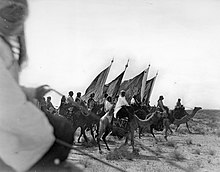

Napoleon employed a camel corps for the French invasion of Egypt and Syria. During the late 19th and much of the 20th centuries, camel troops were used for desert policing and patrol work in the British, French, German, Spanish, and Italian colonial armies. Descendants of such units still form part of the modern Moroccan and Egyptian armies and the paramilitary Indian Border Security Force.
The British-officered Egyptian Camel Corps played a significant role in the 1898 Battle of Omdurman;[15] one of the few occasions during this period when this class of mounted troops took part in substantial numbers in a set-piece battle. The Ottoman Army maintained camel companies as part of its Yemen and Hejaz Corps, both before and during World War I.
The Italians used Dubat camel troops in Italian Somaliland, mainly for frontier patrol during the 1920s and 1930s. These Dubats participated in the Italian conquest of the Ogaden in 1935–1936 during the Second Italo-Ethiopian War.
Colonial authorities in the Spanish protectorate in Morocco used locally recruited camel troops in the northern part of the protectorate, mainly for frontier patrol work from the 1930s until 1956. Forming part of the Tropas Nomades del Sahara, these camel-mounted units had a limited local role in the Spanish Civil War during 1936–1939.[16]
The Jordanian Desert Patrol still uses camels. [17]
Bikaner State (now Bikaner, Rajasthan) maintained a unit called the Bikaner Camel Corps that fought in China during the Boxer Rebellion in 1900, in Somaliland from 1902 to 1904 during the Somaliland Campaign, in Egypt during the Middle Eastern theatre of World War I in 1915 where they destroyed the Turkish forces during the Raid on the Suez Canal with a camel cavalry charge and in the Mediterranean and Middle East theatre of World War II.
The auxiliary defense forces of the Kingdom of Jaisalmer, which had by then become a part of India, also established a camel-mounted defense battalion in 1948.[18][19]They were used for transportation purposes during the Indo-Pakistani War of 1947–1948. Both the camelry units were handed over to the Indian Army's Grenadiers Regiment during the 1951 merger of the local Rajasthani armies with the Grenadiers. They were incorporated into the regiment as its 13th battalion.[20] The Grenadiers used them for both transportation and fighting during the Indo-Pakistani War of 1965 where they prevented Pakistani forces from infiltrating and capturing territory intended to be used as negotiating chips in the Bikaner and Jaisalmer sectors both before and after the ceasefire. Major Jai Singh carried out a camel-mounted raid inside the Pakistani post of Ghoriwala. Another camel-assisted Indian attack at Tanot led to the deaths of 102 Pakistani soldiers, including two officers, and successfully regained a large amount of Indian territory.[19] Many Indian Army camels were also given to the Border Security Force (BSF) upon its conception in the aftermath of the 1965 war.[21]In 1966, the Grenadiers added another camelry battalion, the 17th battalion led by Lieutenant Colonel KS Harihar Singh.[19]In 1967, a camel artillery regiment, the 185 Light Regiment (Pack), was also raised. The 185 Light Regiment (Pack) gave away its camels to the Border Security Force in 1971 on the insistence of Major General J. F. R. Jacob, the then-commander of the army's Eastern Command and a major advocate for mobile warfare who found camels to be too old fashioned for modern military use and had them replaced with gun-towing vehicles,[22] however the 13th and 17th Grenadier battalions[19]and the Border Security Force [21] continued to use camels for infantry purposes. In the same year, camels were once again used in the Indo-Pakistani War of 1971 by both the grenadiers as well as the BSF, who fought alongside the army in the Eastern Theatre.[21] The 13 and the 17th camel-mounted Grenadier battalions fought in the Bikaner and Gadra sectors where they captured a significant amount of territory.[19] Five BSF camels were killed in the Battle of Longewala, one of the most significant battles of the war.[23] The Indian Army finally stopped using camels in 1975. A local officer rejected a subsequent attempt to convert the 13th Grenadiers battalion and the 24th Rajput battalions into camel-mounted units.[19]
Camels are still used by the Border Security Force for patrolling the remote areas of the Thar Desert lying along the India–Pakistan border in Rajasthan. Camels are purchased between ages five and six and trained at the Camel Training Centre at the BSF Frontier Headquarters at Jodhpur. They serve for 15–16 years and are retired from service at the age of 21. The camels used by the BSF are from three different breeds. The Jaisalmeris and the Bikaneris are used for border patrol, while the Nachnas are used for ceremonial duties. The BSF is also known for the yearly participation of its camel contingent in the Delhi Parade for the occasion of the Indian Republic Day since 1976. Inspector General KS Rathore is credited with enhancing the band's capabilities during his years as an inspector general from 1986 to 1989. The camel contingent has two groups, one consisting of camels ridden by border guards and the other being Border Security Force Camel Band, consisting of camels walking along with musicians who march on foot. Both of these elements perform together during the march of the camel contingent. The contingent generally consists of 90 camels[24][21][25]
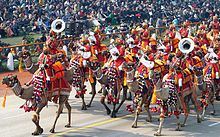

See also
[edit]- War wagon
- Camel train
- Bikaner Camel Corps (Indian)
- Dromedarii (Roman)
- Imperial Camel Corps (British Empire)
- Méhariste (French)
- Somaliland Camel Corps
- Sudan Defence Force
- Tropas Nómadas (Spanish)
- United States Camel Corps
- Zaptié (Italian)
- Zamburak (camel-mounted artillery)
References
[edit]- ^ Herodotus (440 BC). The History of Herodotus. Rawlinson, George (trans.). Retrieved 4 December 2012.
He collected together all the camels that had come in the train of his army to carry the provisions and the baggage, and taking off their loads, he mounted riders upon them accoutred as horsemen. These he commanded to advance in front of his other troops against the Lydian horse; behind them were to follow the foot soldiers and, last of all, the cavalry. When his arrangements were complete, he gave his troops orders to slay all the other Lydians who came in their way without mercy but to spare Croesus and not kill him, even if he should be seized and offer resistance. Cyrus opposed his camels to the enemy's horse because the horse has a natural dread of the camel, and cannot abide either the sight or the smell of that animal. By this stratagem he hoped to make Croesus's horse useless to him, the horse being what he chiefly depended on for victory. The two armies then joined battle, and immediately, the Lydian war-horses, seeing and smelling the camels, turned round and galloped off, and so it came to pass that all Croesus' hopes withered away.
{{cite book}}: CS1 maint: numeric names: authors list (link) - ^ "Cameliers and camels at war". New Zealand History online. History Group of the New Zealand Ministry for Culture and Heritage. 30 August 2009. Retrieved 5 December 2012.
- ^ Jim Hicks, page 21 "The Persians", Time-Life Books, 1975
- ^ Cassin-Scott, Jack (June 1977). The Greek and Persian Wars 500-323 BC. Bloomsbury USA. p. 34. ISBN 0-85045-271-6.
- ^ Herodian of Antioch, History of the Roman Empire (1961) pp.108-134. Book 4. CHAPTER XIV
- ^ D'Amato, Rafaele (23 May 2017). Roman Army Units in the Eastern Provinces (1). Bloomsbury USA. p. 41. ISBN 978-1-4728-2176-8.
- ^ Esposito, Gabriele (3 May 2016). The Late Roman Army. Winged Hussar. p. 85. ISBN 978-0-9963657-9-6.
- ^ Cassin-Scott, Jack (2022). Roman Army Units in the Eastern Provinces (2). Bloomsbury USA. pp. 37–38. ISBN 978-1-4728-5049-2.
- ^ Nicolle, David (26 March 1991). Rome's Enemies 5. The Desert Frontier. Bloomsbury USA. pp. 20 & 21. ISBN 1-85532-166-1.
- ^ Rocca, Samuel (24 November 2009). The Army of Herod the Great. Bloomsbury USA. p. 46. ISBN 978-1-84603-206-6.
- ^ Nicolle, David (26 March 1991). Rome's Enemies 5. The Desert Frontier. Bloomsbury USA. pp. 34 & 37. ISBN 1-85532-166-1.
- ^ Mubarakpuri, Saifur Rahman Al (2005), The sealed nectar: biography of the Noble Prophet, Darussalam Publications, p. 246, ISBN 978-9960-899-55-8
- ^ Nicolle, David (29 July 1982). The Armies of Islam 7th-11thm Centuries. Bloomsbury USA. p. 11. ISBN 085045-448-4.
- ^ Adapted from Watters I:74,77.
- ^ Tauris, I. B. (28 April 2016). Kitchener. Hero and Anti-Hero. Bloomsbury Academic. pp. 84–85. ISBN 978-1-78453-350-2.
- ^ Jose M. Bueno, pages 155–156, Uniformes Militares de la Guerra Civil Espanola, Liberia Editorial San Martin, Madrid 1971
- ^ Jordan's Bedouin 'desert forces' - Middle East - Al Jazeera English. 2010
- ^ Sukhdev (2024-07-25). "The Bhati Rajputs of Jaisalmer". Retrieved 2024-12-31.
- ^ a b c d e f Rikhye, Ravi (2003). "The Indian Army's Camel Troops 1948–75". Orders of Battle. Archived from the original on 14 June 2006.
- ^ "Rajputs State forces to modern Indian Army: A millennium of military service". Rajput Community Forum. 2020-01-05. Retrieved 2023-07-20.
- ^ a b c d Menon, Aparna (2015-12-01). "Did you know The Border Security Force has a camel band? Here's all about BSF and Its Camels". The Better India. Retrieved 2023-07-16.
- ^ "The 1971 Battle of Longewala: A night of confusion, Sam Manekshaw's order, Pakistan's folly". 3 December 2019.
- ^ "Years later, Longewala reminds the do-or-die battle | Jaipur News – Times of India". The Times of India. 18 December 2013.
- ^ "BSF to buy over 300 camels for patrolling Indo-Pak border". The Times of India. 2022-12-29. ISSN 0971-8257. Retrieved 2023-07-16.
- ^ "News Headlines, English News, Today Headlines, Top Stories". Hindustan Times. Retrieved 2023-07-20.

